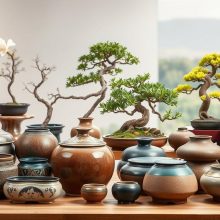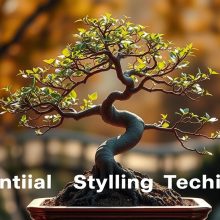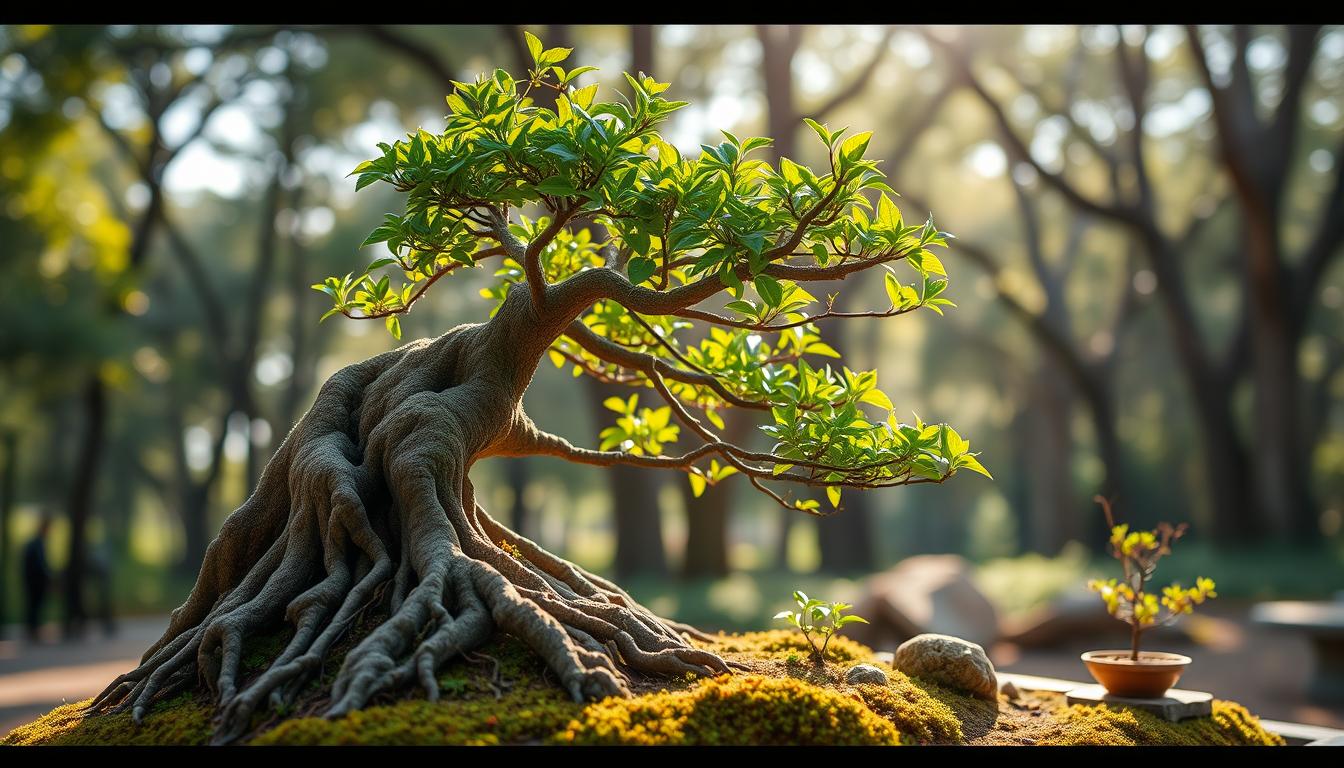Essential Bonsai Pruning Tips for Perfect Miniature Trees
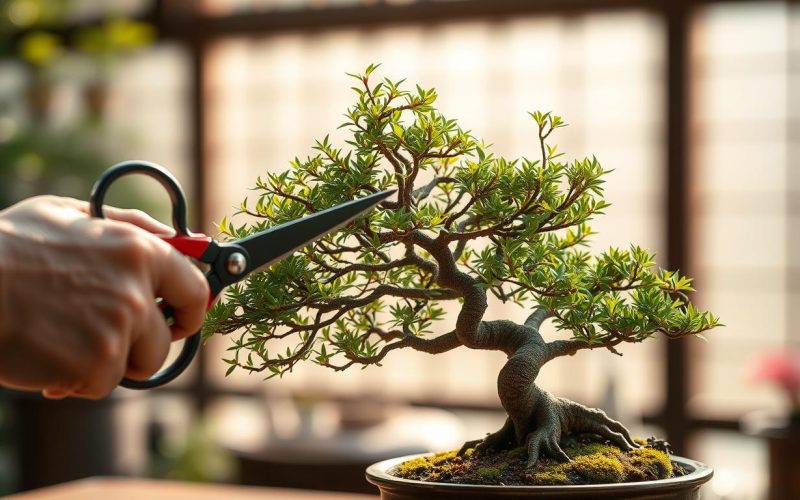
Bonsai tree care is a detailed art that turns regular plants into beautiful miniatures. People often think bonsai trees are special dwarf species. But, they are actually ordinary plants that have been trained through careful pruning.
Each cut and trim is a thoughtful choice to shape the tree’s growth and size. This process creates living sculptures that show the beauty of nature.
Learning bonsai pruning takes patience, precision, and a deep understanding of plants. Those who master this art can turn regular trees into stunning miniatures. These trees show beauty, balance, and artistic vision.
The journey of growing bonsai trees starts with learning basic pruning principles. It’s not just about random trimming. It’s about using strategies that respect each plant’s growth patterns and species characteristics.
Enthusiasts learn to understand their trees, making smart choices that help the tree grow while keeping it healthy. This way, they can create beautiful miniature landscapes.
Key Takeaways
- Bonsai trees are regular plants trained through careful pruning
- Pruning requires understanding plant biology and growth patterns
- Strategic trimming creates miniature living art forms
- Each pruning decision impacts tree structure and appearance
- Professional techniques transform ordinary plants into extraordinary landscapes
Understanding the Importance of Pruning
Bonsai trees need careful attention to keep their beauty and health. Pruning is key in bonsai care, helping gardeners shape and control tree growth. Trees grow with a natural focus on the central stem, making side branches grow slower.
Benefits of Pruning for Bonsai Trees
Pruning is crucial for bonsai shaping. It offers many benefits:
- Controlling tree size and shape
- Promoting dense and compact foliage
- Redirecting energy to specific branches
- Maintaining overall tree health
- Enhancing aesthetic appeal
Common Misconceptions About Pruning
Many beginners think pruning harms trees. But, proper pruning is vital for bonsai growth. Some common mistakes include thinking pruning weakens trees or that all branches can be cut randomly.
Good bonsai care means understanding each tree’s growth pattern. Pruning is not about cutting down trees but about guiding their growth. It helps shape the tree into a desired form while keeping it healthy.
Tools Needed for Bonsai Pruning
For successful bonsai growing, you need the right tools. Professional bonsai artists know that quality tools are key. They help keep the tree healthy and looking good.
Choosing the right tools is important. Professional-grade tools give clean cuts and protect the tree’s structure.
Essential Pruning Tools for Bonsai Enthusiasts
- Pruning Shears: Precision cutting for branches and stems
- Concave Cutters: Creating clean, healing-friendly cuts
- Wire Cutters: Safely removing training wires
- Root Hooks: Carefully managing root systems
- Scissors: Detailed trimming and leaf work
Top Recommended Brands for Bonsai Tools
When buying bonsai tools, look for professional brands. Japanese brands like Ryuga, Kikuwa, and Kiku are top choices. They offer tools made for precise bonsai care.
It’s important to keep your tools clean. Always disinfect them after use. This prevents disease and keeps your tools working well.
Timing Your Pruning Sessions
Knowing the best times to prune is key for bonsai tree care. The right timing can greatly affect your tree’s health and look. Each bonsai type needs pruning at specific times based on its growth cycle.
Pruning bonsai trees isn’t a one-size-fits-all job. The timing depends on several important factors. These factors affect your tree’s growth and beauty.
Seasonal Pruning Guidelines for Different Bonsai Species
- Deciduous trees: Best pruned in late winter or early spring before new growth emerges
- Evergreen species: Ideal pruning window is during active growth periods in spring and early summer
- Tropical bonsai: Can be pruned year-round with careful consideration of growth patterns
Critical Signs It’s Time to Prune
Knowing when to prune is an art in bonsai care. Look for these signs:
- Branches extending beyond desired shape
- Dense foliage blocking interior growth
- Unbalanced canopy development
- Branches crossing or rubbing against each other
Experts say to prune bonsai trees often during the growing season. Outdoor bonsai need care from early spring to late fall. Indoor ones can be pruned more flexibly.
Techniques for Effective Bonsai Pruning
Learning bonsai pruning tips is key to growing beautiful miniature trees. Pruning is more than just cutting—it’s an art that needs precision and skill.
Professional bonsai artists know that pruning is not random. Each cut must be thought out and planned.
The Pinching Technique Explained
Pinching is a gentle bonsai pruning tip that controls growth and shape. It involves removing new shoot tips with your fingers or special tools.
- Best for controlling branch development
- Works well with soft-stemmed species
- Encourages compact, dense growth patterns
Thinning vs. Aesthetic Pruning
It’s important to know the difference between thinning and aesthetic pruning. Thinning is about tree health, removing too many branches. Aesthetic pruning is about making the tree look good.
- Thinning removes dead or overcrowded branches
- Aesthetic pruning shapes the tree’s design
- Using both techniques balances growth
Choosing the right pruning method depends on the bonsai species and its growth habits.
Understanding Bonsai Growth Patterns
Learning to care for bonsai trees means knowing how they grow. Each bonsai type grows differently. This affects how you prune and maintain them.
Bonsai trees grow in ways shaped by their biology. Knowing these patterns is key to growing a healthy bonsai.
Exploring Growth Characteristics of Bonsai Species
Every bonsai species grows in its own way:
- Coniferous trees grow tall and strong
- Deciduous trees branch out more
- Tropical bonsai grow fast
- Evergreen trees grow steadily all year
Pruning’s Impact on Bonsai Development
Pruning is crucial for bonsai growth. It shapes the tree, controls energy, and encourages branch growth. Understanding how trees grow helps shape them.
Pruning is used to:
- Keep leaves small and balanced
- Guide growth to certain branches
- Make the tree look balanced and beautiful
- Stop the tree from growing too tall
Caring for bonsai trees takes patience and knowledge. You need to understand each tree’s growth potential.
Pruning Different Types of Bonsai
Pruning bonsai trees varies a lot based on the tree type. Each bonsai needs its own way to shape and care for. Knowing what each bonsai needs helps make beautiful mini landscapes.
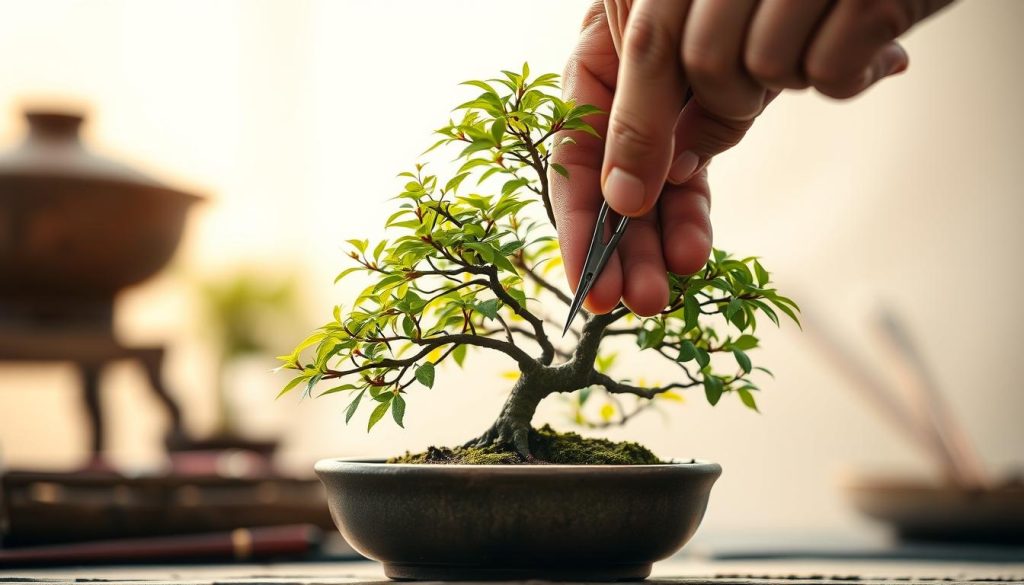
Conifers: Delicate Pruning Approaches
Coniferous bonsai need extra care when pruning. Trees like pine require special pruning tips to stay healthy and look good. Unlike other trees, conifers are best pruned with fingers, not sharp tools.
- Use fingers to pinch new growth carefully
- Avoid scissors or shears on delicate conifer shoots
- Prevent brown or dead foliage by gentle manipulation
Deciduous Trees: Precise Pruning Techniques
Deciduous bonsai trees are more flexible in pruning. They do well with strategic pruning to control leaf size and branch development. Trimming carefully helps achieve the desired look while promoting growth.
- Trim during dormant seasons
- Focus on maintaining branch structure
- Remove crossed or weak branches
Learning to prune different bonsai types takes time and effort. Each tree has its own story, told through its shape.
Maintenance After Pruning
Proper bonsai tree care doesn’t stop when you finish pruning. The time after pruning is key for your tree’s health and growth. Knowing the right care will help your bonsai heal fast and grow strong.
After pruning, your bonsai needs extra care to stay healthy. A good bonsai care guide suggests several important steps:
- Protect pruning wounds with specialized cut paste
- Adjust watering schedule to support healing
- Provide appropriate light and temperature conditions
- Monitor tree’s overall health closely
Caring for Your Bonsai Post-Pruning
Quick care is vital after pruning. Apply a high-quality cut paste to seal wounds and prevent infections. This paste helps your bonsai heal faster and reduces stress.
Importance of Fertilization Post-Pruning
Fertilization is key after pruning. Use a balanced, gentle fertilizer that supports new growth. Start with half the usual amount to avoid stressing your bonsai.
By following these steps, your bonsai will recover fast and keep growing beautifully.
Identifying and Managing Pruning Mistakes
Bonsai pruning needs precision and care. Even skilled gardeners can make mistakes that harm their trees. Knowing common errors helps avoid long-term damage to your bonsai collection.
Learning bonsai pruning tips is key for your tree’s health and look. Experts say to watch closely and use smart pruning methods.
Common Pruning Pitfalls to Avoid
- Over-pruning: Removing more than 1/3 of the tree’s foliage
- Using dull or inappropriate cutting tools
- Pruning at the wrong time of year
- Ignoring the tree’s natural growth pattern
- Cutting without a clear artistic vision
Correcting Pruning Errors
Act quickly if you make pruning mistakes. Here are some tips to help your bonsai recover:
- Give it enough time to recover after big pruning
- Feed it well and keep it hydrated
- Keep it safe from harsh weather
- Apply special healing products for big cuts
- Watch how it reacts to the pruning
Experts say to be patient and watch closely when fixing pruning mistakes. Each bonsai type reacts differently to pruning. Knowing your tree’s needs is crucial.
How to Shape Your Bonsai
Bonsai shaping turns regular trees into stunning art. It’s all about finding the right balance between looks and health. Bonsai artists see shaping as a thoughtful, strategic process that needs patience and attention to detail.
- Position yourself at eye-level with the tree
- Remove dead or unnecessary branches first
- Visualize the final desired shape
- Make strategic pruning decisions
Basic Bonsai Styles and Pruning Requirements
Each bonsai style needs its own pruning method. The top styles are:
- Formal Upright: Needs vertical symmetry and balanced branches
- Informal Upright: Allows natural, slightly curved trunks
- Slanting: Creates a dramatic angle and movement
- Cascade: Looks like trees growing on steep slopes
Balancing Aesthetics and Health
Good bonsai advice says keep the tree healthy while aiming for beauty. Every cut should think about the tree’s growth, its type, and its future health. Shaping keeps the tree’s natural beauty while guiding its growth with careful pruning.
The Role of Wiring in Pruning
Bonsai shaping goes beyond just pruning. Wiring is key in making these tiny trees look amazing. Pruning cuts off extra growth. Wiring lets you shape branches and the tree’s structure exactly how you want.
Wiring is a basic skill in bonsai care. It lets artists shape branches into beautiful forms. Most trees can be wired, but the right time and method depend on the tree.
Effective Bonsai Branch Wiring Tips
- Select the right wire size for the branch thickness
- Use aluminum or copper wire for different trees
- Wrap wire at a 45-degree angle on branches
- Avoid tight wrapping to prevent bark damage
Understanding Wiring Risks and Benefits
Wiring needs to be done carefully to avoid harm. Wrong wiring can damage bark or break branches. Experts use gentle pressure to shape without stressing the tree.
Good wiring lets you express your art better. It improves the tree’s structure and makes it look natural. This reflects the beauty of traditional bonsai.
When to Wire Your Bonsai
- Deciduous trees: Best wired in late winter
- Evergreen species: Can be wired any time of year
- Avoid wiring in extreme temperatures
- Take off wire before it harms growing branches
Learning bonsai techniques takes time, patience, and knowing each tree. Wiring is an art that turns branches into living sculptures.
Pruning for Bonsai Exhibition
Getting your bonsai ready for an exhibition needs careful attention and special pruning skills. Bonsai styling advice is key to create a tree that wows judges and viewers alike.
Expert bonsai artists know that trees for shows must be perfect. The right pruning tips can turn a simple tree into a breathtaking work of art that grabs attention.
Preparing Your Bonsai for Shows
Preparing for a show involves several important steps:
- Clean and check your bonsai well
- Take out any dead or broken branches
- Make sure it looks balanced and symmetrical
- Trim leaves to show off the tree’s beauty
Specific Pruning Techniques for Exhibition-Ready Trees
Strategic pruning boosts your bonsai’s look. Aim for clean lines, cut off extra growth, and show off the tree’s best features. Make cuts that follow the tree’s natural growth to improve its show value.
- Study the tree’s special traits
- Plan your pruning carefully
- Use sharp, clean tools
- Make thoughtful, precise cuts
- Step back often to check your work
Mastering bonsai pruning for shows takes time, patience, and knowing each tree’s potential. With hard work, your bonsai can become a living masterpiece.
Seasonal Pruning Strategies
Learning the best times to prune is key in bonsai care. Each season brings its own set of challenges and chances to shape your mini trees. Knowing the right pruning methods can greatly improve your bonsai’s health and look.
Every bonsai type needs its own pruning plan for the year. The aim is to work with the tree’s natural growth while keeping it healthy and looking good.
Spring Pruning Strategies
Spring is the most important time for bonsai care. Trees grow fast and are perfect for big pruning jobs during this season.
- Find and cut off dead or weak branches
- Help new growth by careful pruning
- Shape the tree’s overall look
- Shorten long shoots to keep the shape right
Fall Pruning Techniques
Fall is also a good time for pruning some bonsai types. This season’s pruning helps trees get ready for winter and fine-tunes their shape.
- Trim off too much growth from summer
- Make the branch structure cleaner
- Thin out crowded spots for better air flow
- Get the tree ready for winter
Pruning bonsai well needs patience, watching, and knowing each tree’s special traits. Getting better at it takes regular practice and will change how you care for your bonsai.
Monitoring Health After Pruning
After pruning, it’s vital to watch your bonsai’s health closely. Your tree needs extra care to heal and grow well. Knowing the signs of good health helps avoid problems and keeps your bonsai lively and strong.
Signs of a Healthy Bonsai
A healthy bonsai shows several key signs. Your bonsai care guide should point out these important health markers:
- Bright, glossy leaves without discoloration
- Strong, flexible branches with uniform growth
- Consistent new shoot development
- Bark that appears smooth and intact
- Root system showing white or light-colored healthy roots
Troubleshooting Health Issues
Spotting problems early can prevent big damage. Look out for these warning signs of stress or disease:
- Yellowing or drooping leaves
- Presence of small insects or webbing
- Unusual dark spots on leaves or branches
- Stunted growth or lack of new shoots
- Dry or brittle branches
If you see any of these signs, act fast. Check for pests, adjust watering, and ensure enough light. For ongoing or complex issues, seek professional help in your bonsai care routine.
Engaging with the Bonsai Community
Bonsai is more than a hobby—it’s a shared art form. It grows with the help of others. By connecting with enthusiasts, you can improve your bonsai skills and learn more about styling.
Joining the bonsai community offers many chances to learn and grow. Experienced growers share valuable insights. These can change how you care for your trees.
Why Sharing Your Pruning Experience Matters
Sharing your bonsai journey helps everyone. Novices and experts alike can learn from each other. Each pruning experience teaches something new.
- Learn from others’ successes and mistakes
- Receive constructive feedback on your techniques
- Develop deeper understanding of bonsai care
- Build meaningful connections with fellow enthusiasts
Resources for Continuing Education
There are many ways to learn more about bonsai and meet experts:
- Local bonsai clubs and workshops
- Online forums and social media groups
- Regional bonsai conferences
- Professional training courses
- Specialized bonsai websites and blogs
By always learning, your bonsai skills stay sharp. The bonsai community is welcoming to all. It’s a place where everyone can grow together.
The Future of Your Bonsai
Bonsai tree care is a journey of patience and vision. It turns simple plants into living artworks that can thrive for generations. Your bonsai maintenance guide should include thoughtful planning and consistent care.
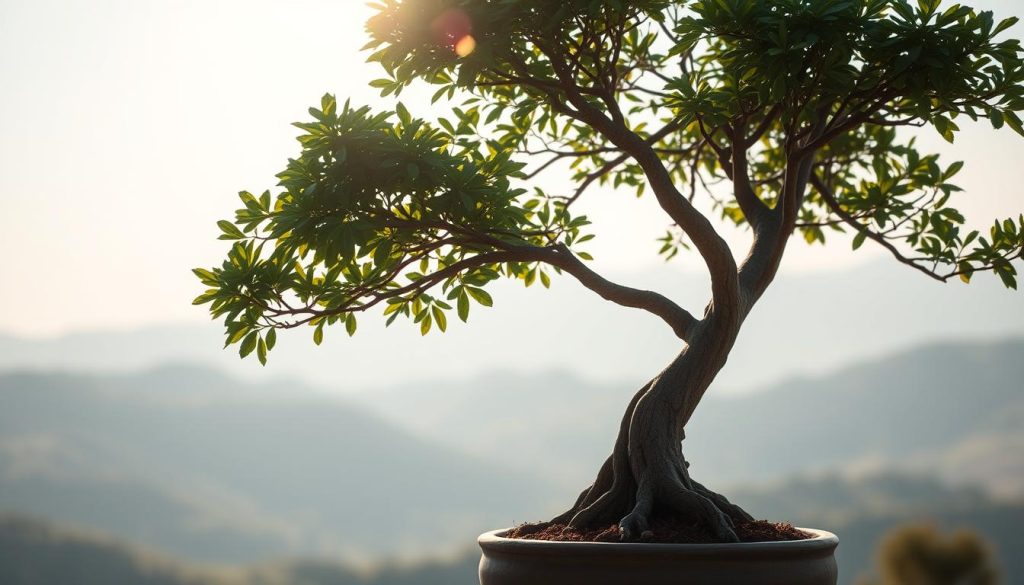
Creating a successful bonsai requires strategic thinking about its future growth. Your pruning approach is key in shaping the tree’s ultimate form and health.
Setting Long-Term Goals for Your Trees
- Visualize the mature tree’s desired shape and structure
- Create a multi-year pruning and training schedule
- Select species compatible with your climate and care capacity
- Invest in high-quality tools for precise maintenance
How Pruning Contributes to Longevity
Pruning is more than just shaping the tree. It’s a key part of bonsai tree care that supports tree health. Regular, strategic pruning helps:
- Control tree size and shape
- Stimulate healthy growth patterns
- Remove damaged or diseased branches
- Improve overall tree resilience
By seeing pruning as a long-term investment, you’ll create bonsai that are not just plants. They are living sculptures with remarkable potential for growth and beauty.
Conclusion: Mastering Bonsai Pruning
Bonsai pruning is more than a hobby; it’s an art form that needs dedication and patience. Learning bonsai pruning tips can turn a simple hobby into a fulfilling practice. Each cut and trim is a chance to shape a tree and learn about botanical art.
Getting good at bonsai takes time and practice. Successful bonsai lovers know each tree has its own story. The skills you learn about timing, tools, and techniques will help you create stunning miniature landscapes.
Embracing Your Bonsai Journey
Remember, every bonsai expert began where you are now. See each challenge as a chance to learn and grow. Try new techniques, watch how your trees react, and don’t worry about mistakes. Your dedication to these tiny trees will show in your bonsai art.
Continuing Your Bonsai Education
The bonsai world is always changing and full of wonder. Join local bonsai clubs, go to workshops, and meet experienced bonsai artists. Your bonsai journey is a lifelong adventure of discovery, creativity, and connecting with nature.
